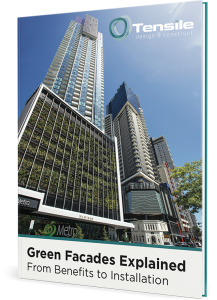One of the great things about green infrastructure is that it’s all about the creation of ‘living’ structures. Living green structures have the capacity to absorb pollution, cool and shade buildings, and even increase local biodiversity.
The Junglefy breathing wall in Melbourne for example has been demonstrated to remove 95% of air particulates within minutes, as well as humidify and cool indoor air and absorb noise.
Green infrastructure can even be used to create micro-farms and to produce food plants. And with some clever design and planning, green structures can attract various kinds of beneficial wildlife such as bees.
Why does it matter? The role of biodiversity in human health
According to the World Health Organization, the loss of biological diversity in a region can have a direct effect on human health. Thriving ecosystems are integral to the production of food and medicinal plants, for example.
Without biological diversity ecosystems can also become unbalanced, which can lead to the proliferation of some species at the expense of others. This can even lead to outbreaks of infectious diseases in some instances.
So it would appear that biodiversity can have a significant impact on our health and wellbeing, often in ways that might not be very obvious – particularly to those of us living in built-up areas.
But built environments can suffer from a lack of biodiversity, which is where green infrastructure can be useful.
How green structures can contribute to biodiversity
Green infrastructure creates an interaction between buildings and plants. A well-designed green wall or green facade can increase the level of biodiversity in numerous ways.
For instance, a green wall could incorporate certain plants specifically to attract native or rare species of birds.
Examples include plants that attract insects for the birds to feed on, or that provide food for seed or nectar feeders.
A vertical garden could also be designed to attract beneficial insects such as bees for pollination, or species of beetles that feed on unwanted garden pests.
At Tensile, we specialise in green facades for multistorey and commercial buildings. If you have a green facade in mind to increase biodiversity or to beautify or improve the health of a building, get in touch to discuss how we can help.





































